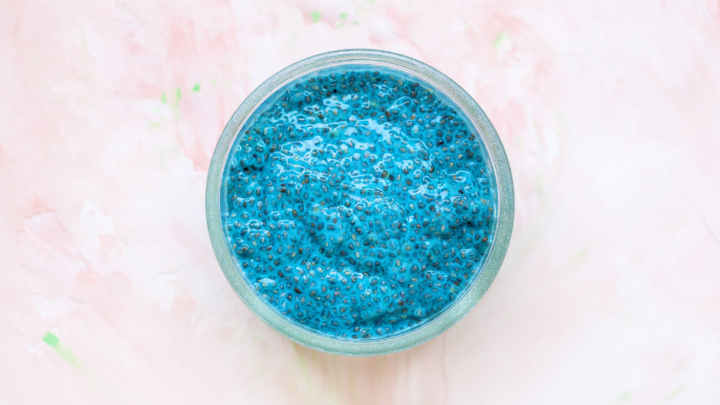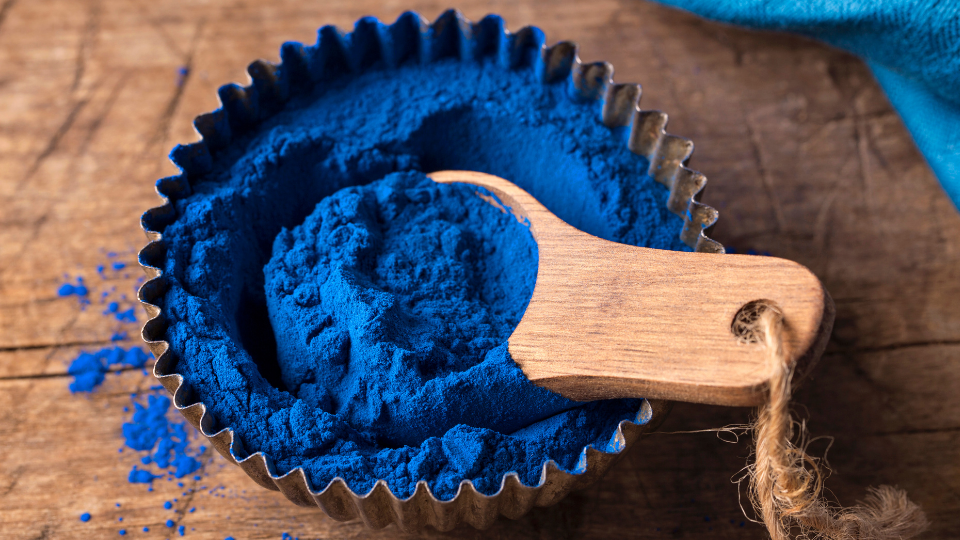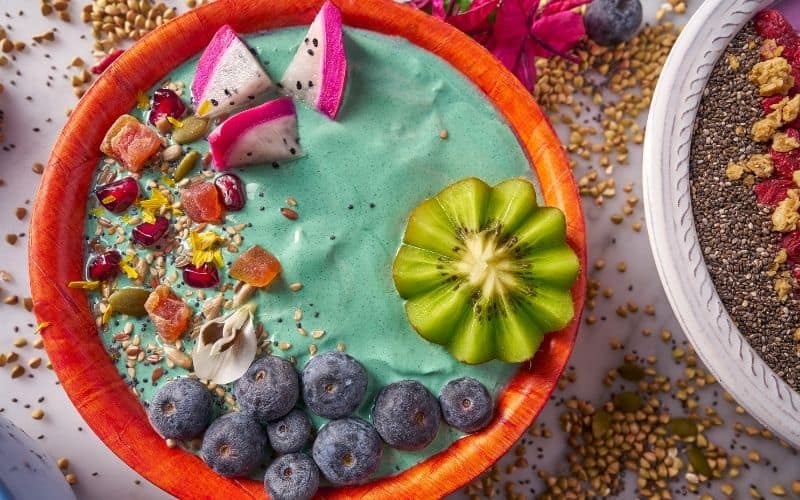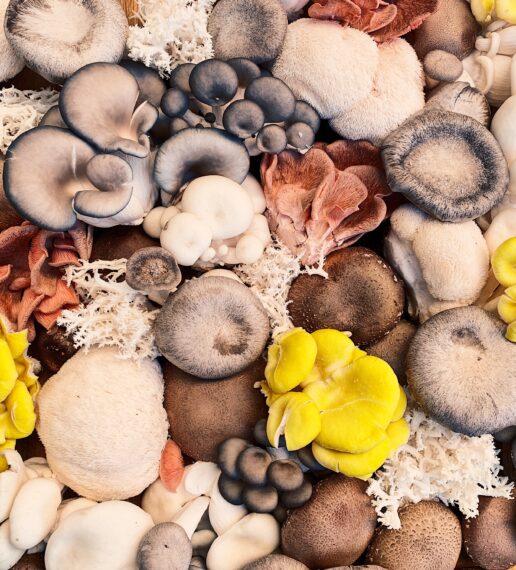Should You Add Blue Spirulina To Your Diet?

Contents
Algae may not sound like the most appetizing food but this variety is actually packed with valuable nutrients that you can’t find anywhere else.
Like many people, you may not feel 100% sure about adding spirulina to your diet. Sure, it has a cute Disneyesque name but it’s algae, so how can it possibly taste halfway decent?
Today, we’ll go over everything you need to know about not just spirulina but blue spirulina: what it is, the health benefits, how to add it to your diet, side effects, and much more.
What is Blue Spirulina?
Spirulina is derived from cyanobacteria: known casually as blue-green algae and known in scientific circles as Arthrospira platensis.
You may find spirulina in many superfood powders mixes due to its potent nutrient profile and powerful health benefits. Currently, researchers are studying this alga for promising results fighting cancer, anemia, hepatotoxicity, and vascular disease.
Spirulina contains a special antioxidant compound called phycocyanin – its #1 active ingredient.
Not only does phycocyanin give spirulina its brilliant blue color, but it also provides powerful anti-inflammatory and free-radical fighting qualities.
Blue Spirulina Vs. Green Spirulina
Green spirulina is the algae in its most basic form. Farmers harvest the algae from ponds or controlled environments, dry the algae, and grind it into that familiar blue-green powder.
To make blue spirulina powder, manufacturers extract the phycocyanin from the algae and sell it in its extracted form. Since this type of spirulina powder is nothing more than phycocyanin in its purest form, it has a bright blue pigment without any traces of green.
People say blue is one of the most difficult colors to find in nature so this variety of spirulina might be the best source for natural blue color.
Not only can you use blue spirulina to brighten your dishes, but you also get a higher concentration of antioxidants since you’re buying pure phycocyanin.
Health Benefits of Spirulina

In one tablespoon of spirulina, you’ll feed your body 11% of your recommended iron intake, a whopping four grams of protein, 21% of your recommended copper intake, and plenty of B vitamins for metabolism support.
What are the health benefits of spirulina? Blue-green algae are packed with nutrients for numerous possibilities to support physical health and wellness.
1. Immune System Support
Research from UC Davis found that spirulina is a powerful substance for immune support because it increases the production of cytokines which fight infection. (1)
Spirulina functions in the body as an immunomodulator that shows promise for reducing histamine production in animals with allergies as well.
2. Improve Weight Loss Potential
B vitamins are necessary to help your body digest, process, and turn food into efficient energy. Since spirulina contains vitamins B1, B2, and B3, it can help support your metabolism for weight loss efforts.
Not only that, but spirulina contains four grams of protein per serving. Whip up a spirulina smoothie 30 minutes before your plan to eat a meal and watch your appetite cravings shrink.
3. Perfect for Vegan Diets
Vegan bodybuilders rejoice: spirulina is one of the few plant-based complete proteins. In other words, spirulina contains all nine essential acids needed for muscle growth that your body can’t make on its own.
Add a scoop of spirulina to your favorite post-workout shake for an extra amino acid, protein, and antioxidant boost.
4. Natural Energy from B Vitamins
It may sound crazy but humans aren’t supposed to rely on coffee for energy. Most of your energy should come from whole food sources.
B vitamins help ensure that your food is used efficiently as an energy source – and spirulina has plenty of them.
5. Potent Antioxidant Potential
The real power of spirulina lies in its antioxidant potential.
Oxidative stress leads to free radical damage which causes inflammation and age-related diseases across the body.
Spirulina is packed with phycocyanin: an impressive antioxidant which defends the body against free radical damage.
6. Reduces Inflammation
Acute inflammation is annoying but chronic inflammation can lead to cancer and even dementia. Fortunately, its antioxidant properties make spirulina the perfect natural solution for fighting inflammation.
Studies show that the phycocyanin in spirulina is very effective for inhibiting your inflammatory response. (2)
7. Possible Anti-Cancer Properties
While it’s certainly not a miracle cure, spirulina is currently under research for its cancer-fighting properties.
In rats, spirulina supplementation reduced the size of cancerous tumors. A study looking at patients in India found that spirulina made pre-cancerous lesions in their mouths disappear in 45% of cases. After subjects stopped taking spirulina, the lesions resurfaced. (3)
Another study found that spirulina was more effective for treating pre-cancerous oral lesions than the leading medication. (4)
8. May Reduce Blood Pressure
About one-third of Americans suffer from high blood pressure which can lead to serious complications like heart attacks and strokes. (5)
Studies show that large doses of spirulina can bring blood pressure down to normal levels. (6)
9. Can Help Lower Cholesterol
High cholesterol levels are another major problem in Western societies – especially the United States. These levels increase your risk of heart disease. (7)
Fortunately, spirulina shows promise as a natural solution for reducing “bad” cholesterol (LDL) and triglyceride levels. Furthermore, the blue-green algae protect LDL from oxidation: a contributing factor to serious heart disease.
10. May Help Improve Allergy Symptoms
If you suffer from hay fever, aka allergic rhinitis, you know how frustrating it can be. You may not know, however, that spirulina is a well-known (and effective) alternative treatment for hay fever.
Studies show that spirulina is an effective natural solution for hay fever. The answer likely stems from spirulina’s antioxidant and anti-inflammatory properties. (8)
How to Use Spirulina
Spirulina is easy to incorporate into your diet with smoothies or – even better – smoothie bowls.
The trend of smoothie bowls originally started as acai bowls in places with access to lots of fresh fruit, particularly Hawai’i.
Simply mix up your favorite smoothie with a scoop of spirulina powder. Pour the finished smoothie into a bowl and top with granola, fruit, nuts, seeds, honey, nut butter, and anything else you think sounds good.
In its natural blue-green form, spirulina has a somewhat fishy taste and pond water smell that some people find off-putting. However, this smell and taste disappear once you mix the spirulina into your juice or smoothie.
Blue spirulina, on the other hand, does not have any fishy smell or taste.

What to Watch Out For
Naturally, spirulina grows in ponds where it could be susceptible to runoff contamination and heavy metals.
Choose a brand that grows spirulina in a controlled environment and runs tests for contaminants and heavy metals.
Additionally, you’ll want to select an organic variety free from genetically modified ingredients and any fillers. Make sure to read the ingredient label to ensure your spirulina hasn’t been cut down with any fillers or unnecessary ingredients.
Is Blue Spirulina Natural?
Yes, blue spirulina is completely natural.
It’s true: the bright blue hue seems almost synthetic or modified. However, phycocyanin in its extracted form is completely blue.
Just make sure to check ingredient labels to verify that a manufacturer hasn’t added their own dyes, pigments, or other ingredients to make the product more visually appealing.
Is Blue Spirulina the Same as Blue-Green Algae?
Yes and no.
Spirulina is blue-green algae. Chlorella, on the other hand, is green algae.
With blue spirulina, the blue aspect – phycocyanin – is isolated from the rest of the algae. When you choose this blue variety of spirulina, you get a higher concentration of antioxidants in each serving. Plus, you can create healthy unicorn drinks and cute blue smoothies.
If you want to reap the full benefits spirulina has to offer, you need to choose the whole blue-green package.
Side Effects and Interactions to Consider
Spirulina is generally very safe to consume in average recommended food amounts: usually a few tablespoons each day.
Exceeding these limits could mean overdosing on specific vitamins and minerals which come with their own sets of negative side effects.
Contaminants in spirulina can severely damage the liver and kidneys and contribute to a broad range of medical problems. Always check labels to ensure the spirulina you purchase was tested for heavy metals and contaminants.
It’s important to mention that spirulina does an excellent job of stimulating the immune system. If you have an autoimmune disorder like lupus, rheumatoid arthritis, or multiple sclerosis, you should probably avoid spirulina as it could activate your immune response.
Furthermore, if you take any medications that suppress the immune system, you should talk to a doctor or healthcare practitioner before taking spirulina.
Spirulina contains phenylalanine so anyone with phenylketonuria should avoid blue-green algae products.
The Bottom Line
Blue spirulina contains an isolated form of phycocyanin which gives it a brilliant blue color and potent antioxidant properties.
To enjoy the full range of benefits, choose traditional blue-green spirulina.
Spirulina is extremely easy to add to your diet with delicious smoothies and smoothie bowls – so get your fix.


Do you have any recommendations on where to purchase or order Quality blue spirulina ?